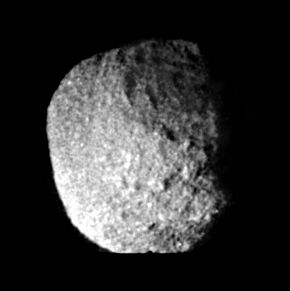Proteus (měsíc)
| Proteus (měsíc) | |
 | |
| Pozorovací údaje (Ekvinokcium J2000,0) | |
|---|---|
| Typ | měsíce Neptunu a měsíc |
| Objevitel | Stephen Synnott a Voyager 2 |
| Datum objevu | 16. června 1989 |
| Zdánlivá magnituda (V) | 19,7 |
| Označení v katalozích | |
| (V) – měření provedena ve viditelném světle | |
| Některá data mohou pocházet z datové položky. | |
Proteus je druhý největší ze známých měsíců planety Neptun. Byl objeven a zatím prozkoumán jen jednou sondou a to Voyagerem 2 v roce 1989. Je největším z Neptunových měsíců, které byly objeveny po Tritonu a Nereidě. Je pojmenován po Próteovi, mořském bohu z řecké mytologie. Jeho původní označení bylo S/1989 N 1. Patří spolu se Saturnovou družicí Phoebe k nejtmavším tělesům sluneční soustavy. Díky své velikosti (průměr téměř 500 kilometrů) se tak nachází na pomyslném rozhraní, kdy se vlivem gravitace začínají takto velká tělesa hroutit do tvaru koule.
Externí odkazy
 Obrázky, zvuky či videa k tématu Proteus na Wikimedia Commons
Obrázky, zvuky či videa k tématu Proteus na Wikimedia Commons - Profil měsíce na NASA's Solar System Exploration
Média použitá na této stránce
Proteus is the second largest moon of Neptune behind the mysterious Triton. Proteus was discovered only in 1989 by the Voyager 2 spacecraft. This is unusual since Neptune has a smaller moon - Nereid - which was discovered 33 years earlier from Earth. The reason Proteus was not discovered sooner is that its surface is very dark and it orbits much closer to Neptune. Proteus has an odd box-like shape and were it even slightly more massive, its own gravity would cause it to reform itself into a sphere.
Original NASA caption: This image of Neptune's satellite 1989N1 was obtained on Aug. 25, 1989 from a range of 146,000 kilometers (91,000 miles). The resolution is about 2.7 kilometers (1.7 miles) per line pair.
The satellite, seen here about half illuminated, has an average radius of some 200 kilometers (120 miles). It is dark (albedo 6 percent) and spectrally grey. Hints of crater-like forms and groove-like lineations can be discerned. The apparent graininess of the image is caused by the short exposure necessary to avoid significant smear.